J ohn Mather marks the ‘Year of Water’ by surveying the geology of Britain’s ‘holy wells’ and spas
ohn Mather marks the ‘Year of Water’ by surveying the geology of Britain’s ‘holy wells’ and spas
Small-talk with new acquaintances invariably involves some discussion of our respective careers. On hearing that much of my life involved working as a ‘water geologist’, and having expressed surprise on my negative reactions to both water divining and bottled water, conversations often turn to discussing the local ‘holy well’ or mineral spring.
These were enthusiastically mapped by the Ordnance Survey during the 19th and 20th Centuries and commonly appear on local maps; but why did our ancestors decide that some springs and wells were sacred, and why did others develop into fashionable spas? Did hydrogeology play any part in their designation or does their origin derive from ancient traditions in which geology played no part?
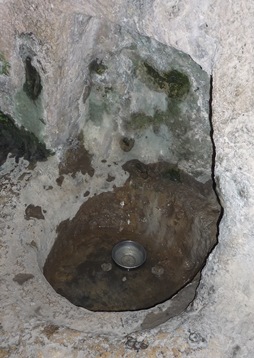 Holy wells
Holy wells
‘Holy wells’ are often portrayed as a link to a pre-Christian past, when our ancestors worshipped deities who controlled the necessities of life, such as sunlight and the flow of streams and rivers. Early missionaries, travelling through the country, incorporated these shrines into the new faith, we are told; changing pagan dedications to Christian ones and perhaps giving their name to the well.
Image right: The small rock pool in the church of St Peter in Antakya (biblical Antioch) in Turkey, water from which was used for baptisms and thought to cure sickness. According to legend the cave-church was founded in AD 47, making this one of the earliest holy wells.
Natural healing powers associated with the well waters became attributed to God and the saints, and pilgrims travelled long distances to be cured by the ‘sacred’ waters. In the 16th Century, following the Reformation, the saints were forgotten; but the medicinal reputation of the waters lived on and sites achieved new distinction as spas and perhaps more recently as hydropathic establishments. This story sounds entirely reasonable. But it is largely myth!
Beginning in the 7th Century, there is little doubt that some ‘holy wells’ originated as springs used for drinking and bathing by some of the great saints of history, and were subsequently venerated in their memory. These carried the name of the saint, becoming, for example, St Cuthbert’s or St Aldhelm’s Well. Others were associated with local hermits or priests, were gathering places which may subsequently have become the site of parish churches, or landmarks associated with a saint. Although some carried saints’ names, many were just called ‘Holywell’.
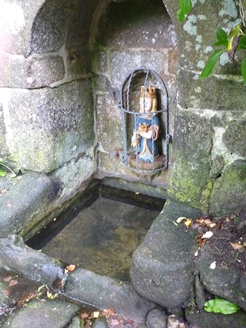 Image left: Sainte Evette’s well at Esquibien in Brittany. St Evette, the virgin of the three crowns, was the patron saint of fishermen in the bay of Audierne. Complete with statuette, the well is probably like many rural holy wells in Britain before they were suppressed at the Reformation.
Image left: Sainte Evette’s well at Esquibien in Brittany. St Evette, the virgin of the three crowns, was the patron saint of fishermen in the bay of Audierne. Complete with statuette, the well is probably like many rural holy wells in Britain before they were suppressed at the Reformation.
From the 12th Century, wells were also dedicated to saints of the universal church, and if the dedication was to the Virgin Mary these became ‘Ladywells’. The well waters were usually of good quality, although some were mildly chalybeate. They were prized for their purity and sweetness and had no intrinsic healing properties. A well was not sacred because it cured people but cured them because of its supposed ‘sanctity by association’. There is little evidence that any of these holy wells were ‘taken over’ from pagan precursors.
Holy wells continued to be designated even after the Reformation. They were common garden features in the 18th Century, fitted with rustic well-houses and saints’ names. Entrepreneurs who wanted to develop a mineral spring during the spa boom of the 18th Century would add a saint’s name for added cachet. Thus, some wells which we might have been regarded as traditional pre-Reformation holy wells, on investigation, turn out to be more recent.
For example, the Chalice Well at Glastonbury, formerly the water supply to the abbey, was first given its sacred title in 1751. St Anne’s Well at Great Malvern is first recorded with this name in 1744, and St Ann’s Well, on the Wick Estate at Hove, was rebranded as such only in the 1880s. In order to explore the part geology might have played in the siting of ‘holy wells’, we must exclude these ‘modern’ examples, ignoring those with no evidence of pre-1600 foundation.
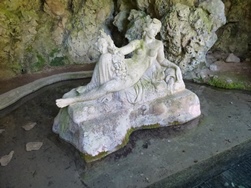 Natural
Natural
At first sight there is little evidence that geology played any part in the designation of a medieval well as holy. The wells are either natural springs, bearing the title ‘well’ because of the basin or sump into which water flows, or dug wells. They occur in all geological environments from hard crystalline rocks such as granite to geologically recent, poorly consolidated, sands and gravels.
Image, right: The source of the River Seine in the Burgundy region of France. In the 17th Century the spring waters were reported to have healing powers and attracted large crowds. A grotto was constructed there in 1868 and the present statue of a nymph arrived in 1934.
Along the Polden Hills in Somerset lies a chain of ‘holy wells’ that perhaps serviced the needs of medieval pilgrims travelling to Glastonbury, after landing from the sea somewhere near Bridgwater. Here, holy wells developed to satisfy a need; but in other areas no such need is apparent.
The folklorist, Jeremy Harte, has listed about 900 wells in England (excluding Cornwall) of likely medieval origin, which equates to a density of five wells per 250 square miles. The density in Cornwall is much greater, at 18 per 250 square miles (similar to Wales, at 17/mile2). Using Harte’s data, the density of holy wells within various areas of England and Wales is listed in the Table, together with an indication of the underlying geology, broken down into three simple groups on hydrogeological grounds.
|
Region
|
Density (wells per 250 sq. miles)
|
Geology
|
|
Cornwall
|
18
|
B
|
|
Wales
|
17
|
B/OC
|
|
West Riding
|
7.5
|
OC
|
|
North East
|
6.6
|
OC
|
|
Welsh Borders
|
6.6
|
OC/YC/B
|
|
Midlands
|
5.9
|
YC/OC
|
|
West Country
|
5.7
|
OC/YC/B
|
|
North of Midlands
|
5.5
|
YC/OC
|
|
Cumbria
|
5.0
|
B/OC/YC
|
|
North West
|
4.8
|
YC/OC
|
|
Home Counties
|
4.7
|
YC
|
|
East and North Ridings
|
4.1
|
YC/OC
|
|
Lincolnshire
|
3.1
|
YC
|
|
Mid-West
|
2.9
|
YC
|
|
South-East
|
2.7
|
YC
|
|
East of Midlands
|
2.6
|
YC
|
|
East Anglia
|
1.5
|
YC
|
Table: B = Basement. OC = Older Cover. YC = Younger Cover.
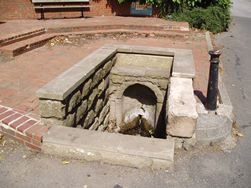 Basement rocks have low porosities and are effectively impermeable. However, even in these hard rocks, fractures in the upper 100m provide small volumes of water to individual springs and wells. Overlying rocks can be divided into an older cover, formed from rocks which are still hard but contain minor aquifers of secondary importance in terms of water supply, and a younger cover, which ranges from the Permian to the Quaternary and contains the principal aquifers.
Basement rocks have low porosities and are effectively impermeable. However, even in these hard rocks, fractures in the upper 100m provide small volumes of water to individual springs and wells. Overlying rocks can be divided into an older cover, formed from rocks which are still hard but contain minor aquifers of secondary importance in terms of water supply, and a younger cover, which ranges from the Permian to the Quaternary and contains the principal aquifers.
Image left: Saint Alkmund’s Well in Derby at the junction of Well Street and Bath Street. Prince Alkmund of Northumbria was murdered, in Derby, about 800 AD and quickly canonised for political reasons. By tradition the well is the site at which his relics rested when they were returned to Derby in the 12th Century.
In the Table, the geology of each region is expressed in terms of these three groups; when more than one group is present these are listed in order of dominance. Even if the detail of the geological breakdown is disputed, the evidence points to one conclusion, namely that wells occur in higher densities in areas underlain by basement and older cover than in areas underlain by younger cover. Put another way, where groundwater is generally readily available there are fewer holy wells than in areas where groundwater is scarce, a situation perhaps opposite to that which might have been expected.
Comparing the southwestern counties of Dorset and Cornwall helps to understand how and why ‘holy well’ densities might vary regionally. To the east, Dorset comes within the Mid-West region in the Table, with a density of 2.9 holy wells per 250 square miles. The younger cover in Dorset includes Cretaceous and Jurassic aquifers. Here groundwater is widely available and it is possible that, in medieval settlements, each group of dwellings had its own well.
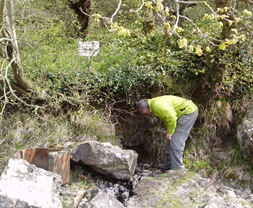 Image, right: A brackish spring emerging from the Carboniferous Limestone at Humphrey Head, near Cartmel in Cumbria, was a spa from the 17th Century. Sometime after 1800 it began to be referred to as Holywell Spa, probably to give it an extra cachet. The sign says “Water not suitable for drinking”. Note the broken salt-glazed stoneware sink to the lower left of the image. Author for scale.
Image, right: A brackish spring emerging from the Carboniferous Limestone at Humphrey Head, near Cartmel in Cumbria, was a spa from the 17th Century. Sometime after 1800 it began to be referred to as Holywell Spa, probably to give it an extra cachet. The sign says “Water not suitable for drinking”. Note the broken salt-glazed stoneware sink to the lower left of the image. Author for scale.
To the west, Cornwall, with a density of 18 holy wells per 250 square miles is underlain by basement rocks - granites and tough Devonian shales as well as equally impermeable rocks within the Lizard and Start complexes. It would have been impractical to sink wells here, and natural streams and springs would have provided water supplies. Unfortunately streams easily become polluted and can rapidly dry up in summer, particularly following periods of below average rainfall. Thus good springs, particularly if perennial, would have been greatly prized. It is easy therefore to understand how they might acquire the status of ‘holy wells’, if only so that people might thus be encouraged to look after them.
The wide variation in pre-Reformation holy well density, as found in England and Wales, is therefore related to the underlying geology, though in an unexpected way. In areas where groundwater was freely available, it was taken for granted; wells were rarely venerated and holy wells uncommon. As groundwater availability decreased, particularly in areas underlain by poorly permeable fractured rocks, reliable sources became valued and venerated, and hence ‘sanctified’.
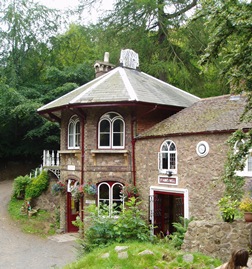 Spas
Spas
With the Reformation, holy wells were suppressed because of their associations with the Papist past. Some major wells were dismantled, but most rural holy wells were small and unobtrusive and survived unscathed. Despite persecution, many laymen retained their faith in holy wells, which were often the scene of social gatherings in summer months.
Image left: St. Ann’s Well at Great Malvern, consisting of a Well House, built in 1813 with an octagonal extension built about 1841. The earliest reference to the well was in 1744, a saint’s name being attached to a drinking spa to give it extra prestige.
In the second half of the 16th Century, this popular attachment to water cures, and a new approach to medicine, led Elizabeth I’s government to adopt a more relaxed attitude, allowing people to drink and bathe in the waters, providing no miraculous element was involved. Cures no longer relied on the blessings or actions of some saint, which were incapable of analysis, but on some property of the water itself.
This led to the growth of ‘spas’ (named for the town of Spa, now in Belgium, where people could both drink and bathe in medicinal waters). Spa wells were nearly all new foundations and were rarely ‘reincarnated’ holy wells. This is because the feature of holy wells was their pure and wholesome water, whereas spa waters were generally characterised by their distinctive (and generally unpleasant) taste, derived from high concentrations of dissolved minerals. There were exceptions. St Anne’s Well in Buxton made the transition from holy well to spa because of its thermal properties, and the Holywell at Malvern because of its exceptional purity, celebrated in the couplet ‘The Malvern water, says Dr Wall/ Is famous for containing just nothing at all’.
The spa movement developed slowly and by the end of the 16th Century there were seven or eight sources, including the thermal resorts of Bath, Buxton and Bristol Hotwells. Over the next century the number of such sites proliferated, particularly after the Restoration in 1660. Spas reached the peak of their popularity during the 18th Century, many spa towns transforming into fashionable watering places, providing a genial environment for the enjoyment of poor health. As well as major centres like Bath, frequented by ‘quality’, there were literally hundreds of small spas catering for all classes, from Pennine lead-miners to middle-class tradesmen and the minor ‘county’ gentry.
Chemical analysis
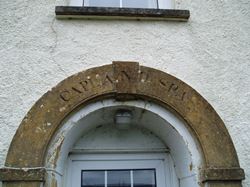 A scientific treatise, extolling the virtues of the Bath thermal springs, was published by Dr William Turner in 1557 and this was the forerunner of a vast literature on British mineral waters. Initially water analysis techniques were crude and it was not until the 19th Century that some sort of order was established in expressing the results of chemical analysis.
A scientific treatise, extolling the virtues of the Bath thermal springs, was published by Dr William Turner in 1557 and this was the forerunner of a vast literature on British mineral waters. Initially water analysis techniques were crude and it was not until the 19th Century that some sort of order was established in expressing the results of chemical analysis.
Image, right: Capland Spa in Somerset. Like many small rural spas, all that remains is a name on a map, or more rarely, as in this case, a name carved above a door.
Most authorities agreed on a general classification, dividing mineral waters into four categories: chalybeate, saline, sulphurous and carbonated. Natural carbonated waters, containing significant volumes of dissolved CO₂, did not occur in Britain, although they could be made up on demand. Chalybeate waters, containing dissolved iron, were perhaps the most widely distributed but did not travel well, as the iron precipitated as brown ochre on exposure to air. For the same reason they were little used for bathing because of the less-than-appetizing brown scum floating on the surface.
Perhaps the best known of the chalybeate spas was Tunbridge Wells in Kent, mildly chalybeate with an iron concentration of about 35mg/l, where water is still dispensed to tourists by a costumed ‘dipper’ in summer months. In comparison, the strongly chalybeate water of Trefriw Spa in North Wales, which has an iron concentration in excess of 500mg/l, is marketed worldwide as Spatone or ‘liquid iron’.
Waters were defined as ‘saline’ if they contained sodium chloride and/or salts of magnesium or another alkali metal. Famous saline spas were those at Epsom, in Surrey, Cheltenham in Gloucestershire and Woodhall Spa in Lincolnshire, none of which still functions. Bath water was also a mild saline. The Epsom source was rich in magnesium and on evaporation precipitated the sulphate, ‘Epsom Salts’, a strong purgative! Sulphurous waters were reduced groundwaters, and less common. For this reason they were considered the most valuable by spa physicians. The most famous was probably at Harrogate, where 88 springs with widely varying compositions rose within a small area along the axis of an asymmetrical anticline.
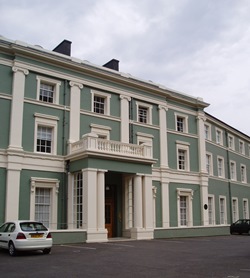 Image, left: Britain’s first purpose-built hydropathic establishment, in Great Malvern, where Dr James Wilson practised from 1845-67. Known as ‘The Establishment’, the building has now been converted to apartments.
Image, left: Britain’s first purpose-built hydropathic establishment, in Great Malvern, where Dr James Wilson practised from 1845-67. Known as ‘The Establishment’, the building has now been converted to apartments.
Spa water composition is governed by the lithology of the host rock and the hydrogeological environment. The latter controls the length of the groundwater flow path and the mixing which takes place along it; the time available for water/rock interaction and the redox conditions encountered. In practice, the location of only a small number of spas is controlled and constrained by geology. These spas lie in natural groundwater discharge zones at the culmination of long flow paths with significant residence times. Discharges are often associated with faults along which flowpaths coalesce as groundwater moves to the surface.
The three best-known spas in the UK - Bath, Buxton and Harrogate - are all of this type. However, at most UK spas, geology is of lesser importance. For example, the saline waters of Cheltenham Spa derive from the clays of the Jurassic Lower Lias. These crop out over an extensive area and discharges of mineralised water are common. However, only Cheltenham grew into a fashionable Georgian spa, as a result of the enthusiasm of local entrepreneurs, rather than any distinctive geology. Some spas have claimed that their waters are ‘juvenile’ or ‘plutonic’ in origin, rise from great depth and have never previously seen the light of day. However, measurements of environmental isotopes have demonstrated that these waters are in fact meteoric in origin - even though recharge may date from the Pleistocene.
Hydropathy
Even before the close of the 18th Century, the spas’ decline had begun - replaced as fashionable watering places by the new seaside resorts. Medical fashions changed and in the mid-19th Century, traditional spa treatments were partly replaced by the practice of ‘hydropathy’, which involved immersing or dousing parts of the body in water or wrapping parts of the body in wet sheets. ‘Wetting and sweating’ therapies had been practised for some years, but were first systematised by a farmer’s son, Vincenz Priessnitz at Gräfenburg, then in Austria. Many medical conditions were considered to be advantageously treated by such methods and the ‘water cure’ became popular for a time.
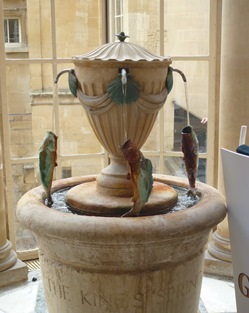 Image, right: The fountain in the Pump Room at Bath. According to 18th century claims, the water ‘strikes the roof of the mouth with sulphur and steel, and amongst other things, strengthens the bowels, cleanses the body from all blotches and itchings and is excellent against deafness, forgetfulness and the weakness of any member’!
Image, right: The fountain in the Pump Room at Bath. According to 18th century claims, the water ‘strikes the roof of the mouth with sulphur and steel, and amongst other things, strengthens the bowels, cleanses the body from all blotches and itchings and is excellent against deafness, forgetfulness and the weakness of any member’!
Treatment involved a tough regimen of exercise, fresh air and abstinence from many of life’s pleasures. An ideal resort required pure water, pure air and easily climbed hills. Most spa resorts did not qualify, the notable exceptions being Malvern, which had traded as a spa, somewhat incongruously, on the purity of its water, and Buxton. Hydropathic establishments, or ‘Hydros’, grew up in new centres, where there were plentiful supplies of weakly mineralised waters, often using surface water from local rivers and lakes rather than groundwater.
Geology or entrepreneurs?
The water of holy wells was generally of good quality, had no measurable healing properties, but gained these through an association with a saint or holy man. Spa waters reputedly healed because of their dissolved mineral content which could be measured by chemists. Following the Reformation, only rarely did holy wells, become the site of spas, as water quality requirements were entirely different. For similar reasons, in the 19th Century, most spas were not revitalised by the introduction of hydropathy. The distribution of holy wells seems to be related to the underlying geology in that they are more common in areas of older fractured rocks.
Geology influences the location of spas, but many owe their fame, primarily, to the efforts of local entrepreneurs.
Further reading
- Harte, J 2008. English Holy Wells: a sourcebook, 3 volumes. Heart of Albion Press. Loughborough.
- Hembry, P 1990. The English Spa 1560-1815. Athlone Press, London.
- Mather, J D 2013. Britain’s spa heritage: a hydrogeological appraisal. In: Duffin, C J, Moody, R T J & Gardner-Thorpe, C (eds). A History of Geology and Medicine. Geological Society, London, Special publications, 375, 243-260.
* Dr John Mather is a retired BGS Hydrogeologist and an enthusiastic potter.